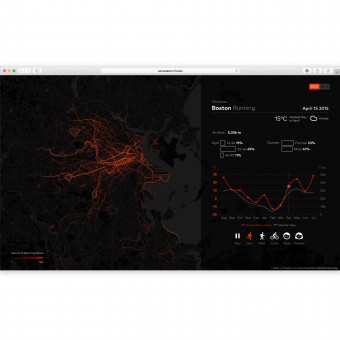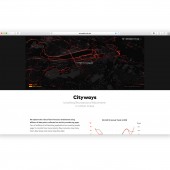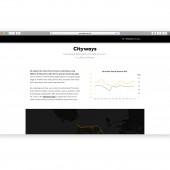CityWays Data Visualization by Hyemi Song |
Home > Winners > #67565 |
 |
|
||||
| DESIGN DETAILS | |||||
| DESIGN NAME: CityWays PRIMARY FUNCTION: Data Visualization INSPIRATION: Currently, fitness tracking applications are present in 60% of smartphones, and constitute a rapidly growing market, with sales of $800 million projected by 2020. They are also behind many ad-hoc devices, such as fitness electronic gear contained in watches and bracelets, among others. While the individual benefits of such apps are well known, the aggregated data they produce has never been studied to better understand cities – at least until now. UNIQUE PROPERTIES / PROJECT DESCRIPTION: CityWays is a research to reveal human's recreational patterns through visualizing datasets from self-tracking applications, quantifying the effects of temperature, precipitation, and other environmental factors. Through finding factors that affect pedestrian activities, we also found implications on street design and zoning policies, possibly leading to a re-definition of well-known static metrics of walkability. OPERATION / FLOW / INTERACTION: By comparing the dataset and external factors especially weather visualized on the CityWays web application, users can have their own suppositions and inquiries about the human's seasonal trip trends of cities, particularly in Boston and San Francisco. Through exploring the landing website, users can have an overall understanding of this research. By investigating the web application that is comprised of two-parts(map and dashboard), they can scrutinize data having deeper insights. PROJECT DURATION AND LOCATION: The project started in December 2016 and finished in August 2017 in Cambridge, MA |
PRODUCTION / REALIZATION TECHNOLOGY: Data Analysis, Data Visualization (Javascript, D3js, Mapbox, Leaflet, Python, HTML, CSS), Data Collection SPECIFICATIONS / TECHNICAL PROPERTIES: Web Application TAGS: Data, DataVisualization, City RESEARCH ABSTRACT: Tens of millions of self-tracking apps are installed annually by people eager to monitor themselves - from how many calories they eat to how many hours they sleep to how many steps they take in the course of a day. While these devices and applications help people realize their fitness goals, researchers, including me at the MIT Senseable City Lab, in collaboration with Liberty Mutual, have found another use for the Big Data they produce. As part of a new study called CityWays, we have analyzed and anonymized data to better understand activity patterns in cities, including how pedestrians, runners and cyclists move in the urban environment. CHALLENGE: Until recently, movement data was difficult to obtain, and required tedious and expensive surveys. But, information from self-tracking apps is a game changer because it allows people to discover how a diverse group of people from different communities move around an urban space – and what are the key factors influencing it. Thus, as the first step, we challenged in finding factors that affect pedestrian activities to redefine metrics of walkability in a city. Using data collected from personal tracking applications helps us better understand how people move around cities - and can lead to more human-centered urban design, grounded in actual data. ADDED DATE: 2018-03-27 03:14:33 TEAM MEMBERS (1) : Carlo Ratti (Director), Hyemi Song (Website, Visualization for App), Fábio Duarte (Project Manager), Ruixian Ma (Visualization for Video), Anthony Vanky (PhD Researcher), Paolo Santi (Research Adviser) IMAGE CREDITS: MIT Senseable City Lab PATENTS/COPYRIGHTS: MIT Senseable City Lab |
||||
| Visit the following page to learn more: http://senseable.mit.edu/cityways/ | |||||
| AWARD DETAILS | |
 |
Cityways Data Visualization by Hyemi Song is Winner in Generative, Algorithmic, Parametric and AI-Assisted Design Category, 2017 - 2018.· Press Members: Login or Register to request an exclusive interview with Hyemi Song. · Click here to register inorder to view the profile and other works by Hyemi Song. |
| SOCIAL |
| + Add to Likes / Favorites | Send to My Email | Comment | Testimonials | View Press-Release | Press Kit |







